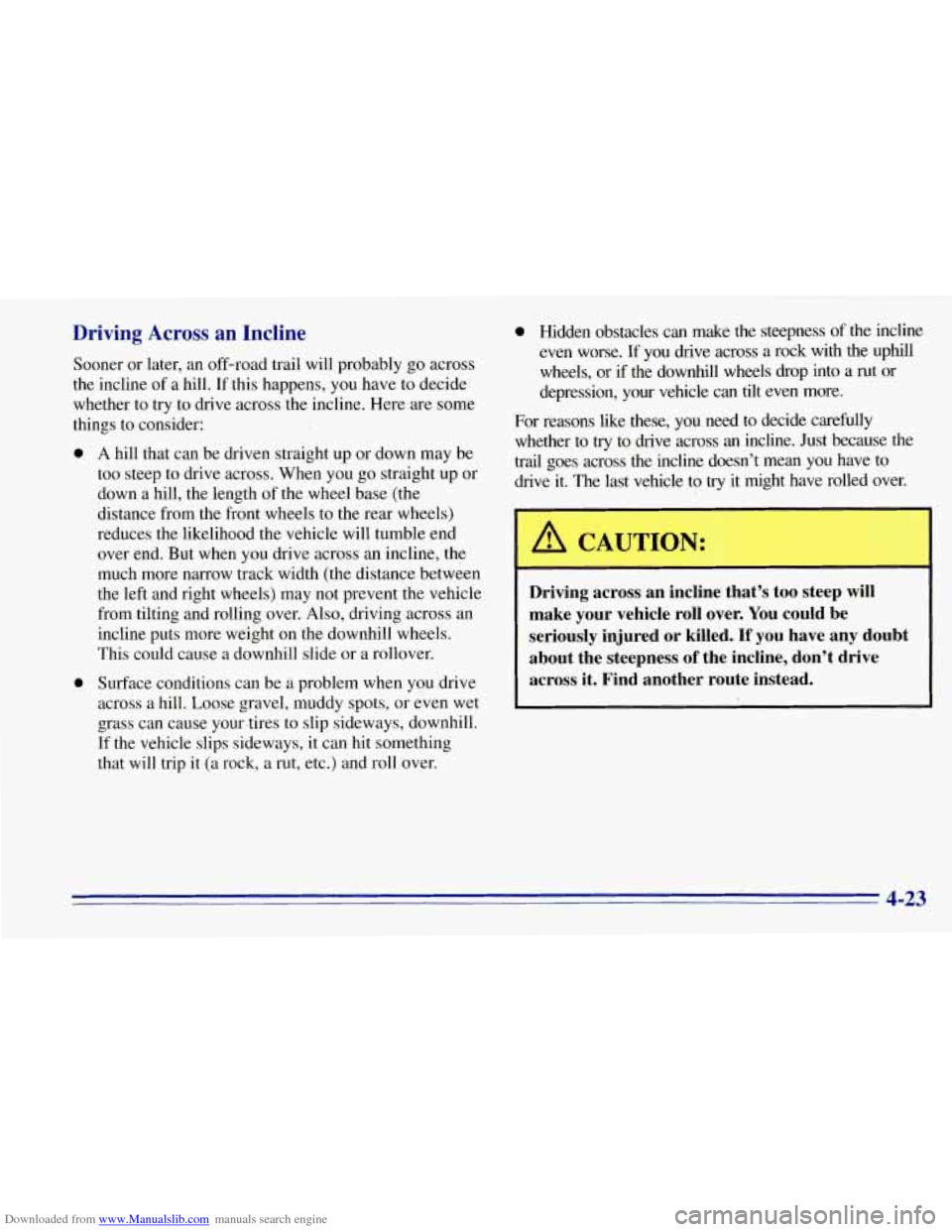Page 161 of 403

Downloaded from www.Manualslib.com manuals search engine Drunken Driving
Death and injury associated with drinking and driving
is a national tragedy. It’s the number one contributor to
the highway death toll, claiming thousands
of victims
every year.
Alcohol affects four things that anyone needs
to drive
a vehicle:
0 Judgment
Muscular Coordination
0 Vision
. Attentiveness.
Police records show that almost half of all motor
vehicle-related deaths involve alcohol. In most cases,
these deaths are the result of someone who was drinking
and driving. In recent years, some 18,000 annual motor
vehicle-related deaths have been associated with the use
of alcohol, with more than
300,000 people injured.
Many adults
-- by some estimates, nearly half the
adult population
-- choose never to drink qlcohol, so
they never drive after drinking. For persons under 21,
it’s against the law in every
U.S. state to drink alcohol.
There are good medical, psychological and
developmental reasons for these laws.
I
The obvious way to solve this highway safety problem
is for people never
to drink alcohol and then drive. But
what
if people do? How much is “too much” if the
driver plans
to drive? It’s a lot less than many might
think. Although it depends
on each person and situation,
here is some general information
on the problem.
The Blood Alcohol Concentration (BAC) of someone
who
is drinking depends upon four things:
0 The amount of alcohol consumed
The drinker’s body weight
0 The amount of food that is consumed before and
during drinking
0 The length of time it has taken the drinker to
consume the alcohol.
According to the American Medical Association, a
180-lb. (82 kg) person who drinks three 12-ounce
(355 ml) bottles of beer in an hour will end up with a
BAC of about
0.06 percent. The person would reach the
same BAC by drinking three 4-ounce (120 ml) glasses
of wine or three mixed drinks if each had 1-1/2 ounces
(45 ml) of a liquor like whiskey, gin or vodka.
4-2
Page 182 of 403

Downloaded from www.Manualslib.com manuals search engine Driving Across an Incline
Sooner or later, an off-road trail will probably go across
the incline of a.hill. If this happens,
you have to decide
whether to try to drive across the incline. Here are some
things to consider:
0
0 A hill that can be driven straight up or down may be
too steep to drive across. When you go straight. up or
down a hill, the length of the wheel base (the
distance from the front wheels to the rear wheels)
reduces the likelihood the vehicle will tumble end
over end. But when you drive across an incline, the
much more narrow track width (the distance between
the left and right wheels) may not prevent the vehicle
from tilting and rolling over. Also, driving across an
incline puts more weight on the downhill wheels.
This could cause a downhill slide or a rollover.
Surface conditions can be a problem when you drive
across a hill. Loose gravel, muddy spots, or even wet
grass can cause your.tires to slip sideways, downhill.
If the vehicle slips sideways, it can hit something
that will trip it (a rock, a rut, etc.) and roll over.
0 Hidden obstacles can make the steepness of the incline
even worse.
If you drive across a rock with the uphill
wheels, or if the downhill wheels drop into a rut or
depression, your vehicle can tilt even more.
For reasons like these,
you need to decide carefully
whether to
try to drive across an incline. Just because the
trail goes across the incline doesn’t mean
you have to
drive it. The last vehicle to
try it might have rolled over.
.
A CAUTION:
Driving across an incline that’s too steep will
make your vehicle roll over. You could be
seriously injured or killed.
If you have any doubt
about the steepness
of the incline, don’t drive
across it. Find another route instead.
4-23
Page 295 of 403
Downloaded from www.Manualslib.com manuals search engine 4. Remove the screws from
the bulb retainer and
take the bulb retainer
off
of the lamp assembly.
5. Pull the old bulb straight out of the socket.
6. Put in a new bulb and push it in until it is tight.
7. Replace the bulb retainer.
8. Replace the rear lamp assembly and tighten the
screws.
You may want to use a magnetic screwdriver
when installing the screws.
9. Close the tailgate or rear doors.
Windshield Wiper Blade Replacement
For proper type and length, see “Normal Maintenance
Replacement Parts” in‘the Index.
To replace the
windshield wiper blade assembly:
1. Lift the wiper arm and rotate the blade until it is..
facing away from the windshield.
2. Push the release lever and slide the wiper assembly
toward the driver’s side
of the vehicle.
3. Install a new blade by reversing Steps 1 and 2.
6-42 . =.
Page 324 of 403
Downloaded from www.Manualslib.com manuals search engine Normal Maintenance Replacement Parts -- Gasoline Engines
Replacement part numbers listed In this section are based on the latest information available at the time of printing,
and are subject to change.
If a part listed in this manual is not the same as the part used in your .vehicle when it was
built, or
if you have any questions, please contact your GM truck dealer.
Engine
VORTEC” 5700
VIN R Oil Filter PF1218T
Air Cleaner Filter
A 1300C
Spark Plugs * 4 1-932
Spark Plug Gap
0.060 in. (1.52 mm)
Fuel Filter GF626
Wiper Blades. (Front) 22154886
Wiper Blade Type (Front) Trico
Wiper Blade Length (Front) 18 inches
(45.0 cm)
Wiper Blade (Rear) 22154396
Wiper Blade Type (Rear) Trico
Wiper Blade Length (Rear) 14 inches (35.5 cm)
“four-Wheel-Drive Vehicles
-- use a PF52 oil filter.
46VORTEC” 7400
J
PF1218
A1 3OOC
4 1-932
0.060 in. (1.52 mm)
GF626
22154886 Trico
18 inches
(45.0 cm)
22154396
Trico
14 inches (35.5 cm)